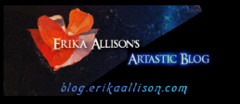Erika Allison's Artastic Blog
Breaking the rules… or not
Posts Tagged ‘artist’
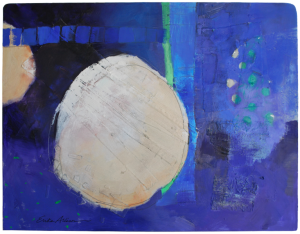
Executive Acres, oil / mixed media on panel - Dimensions: 24 7/8" x 32" x 1 3/4"
I usually don’t know what a work is about until I’m done with it and have it titled. I concentrate on design, composition, color, texture. I view it in all directions. I turn it upside, sideways and back up again, checking to see that I have a good composition. I feel that if one has a good composition the painting will work in any direction. Of course, I eventually have to settle on a direction that I think works best – or that I like the best. Then, I’ll start studying the painting to see what I “see” in it. Abstract work invites the viewer (including the artist) to see what he/she sees in it. Different viewers can see different things. Eventually, something will hit me, a title will come to mind and I’ll know I’m finished.
In this painting I felt like I was seeing outer space. Maybe planets, asteroids, the unknown. And, there’s all this talk about space travel, the new frontier, etc. Private companies are talking about trips into space. And, of course,only the very wealthy will be able to afford this kind of adventure. I’m thinking maybe a home on a new planet takes the place of the big house on the hill. But, then, you may see something altogether different. One of my artist friends sees a moon pie! She’s from the south, in case you couldn’t guess!
This original oil/mixed media painting can be seen at R Space Studio in The Arts Factory, 107 E. Charleston Blvd, Ste. 125, Las Vegas NV through February.
What DOES “filling the well” mean? I’m guessing that most artists have some idea of what it means. It’s a huge and necessary part of the creative process. In order to say something, one has to have something to say! When you work and create and move on to the next project to work and create again – eventually that well can run dry. It needs time to re-fill. The well is what you draw on for ideas. You may consciously dig down in that well, looking for something. But, I think it’s usually a more subconscious thing. It’s not something you think about doing. It just happens. So, when that well is dry or nearly dry, time is needed while it re-fills. And, how does that happen? How does the well fill up again? All your life experiences are part of that well. Every vision, every thought, every encounter, every experience – contribute to filling the well.
So – time and living are the key requirements to filling the well. You need to take some time away from your studio and your creative process. You need to just “be”. Don’t be putting pressure on yourself to come up with ideas for your next creation. There will be plenty of ideas in due time. Your experiences and visions and subconscious thoughts are always pouring into that bottomless well. Even your daydreaming contributes. But, let it all be subconscious. Try to consider yourself “on vacation” from your art. You’re NOT, really. You’re never on vacation from being an artist. It’s who you are. But, TRY to just let your artist lie fallow for awhile. That is when seeds are being sown, ideas are percolating… And, soon enough, you’ll be heading into the studio again, ideas flowing, more than you think you have time to even work on. As if by magic, new ideas appear on your canvas, or whatever ground you work on. It’s an ongoing cycle. Take from the well…refill the well…
Do you have thoughts on filling the well? I’d love to hear from you on how it fits into your creative process.
Tomorrow will be an art-filled day for me. I always enjoy art-filled days. That seems to be my goal: fill ‘er up with art!
I will be at The Ortego Gallery, Las Vegas, all afternoon. I have a show hanging during the month of July: “Unanswered Questions”. Preview Thursday and First Friday were last weekend. I thought it would be nice if I were there sometimes during the month so I’d be available to meet and talk with interested people. Artists who have their own galleries and show their work full-time are always there and available. So, I thought I’d try to be available part-time, at least.
In the evening I will be joining five other artists for Painters On The Patio. We will be painting live, outdoors, on the patio at Bar+Bistro. There will probably be diners on the patio, drinkers on the patio, bocce ball players at the bocce ball court – and, hopefully, interested observers watching us paint. It’s a great atmosphere for creating, night in the arts district.
I have been preparing for my busy day tomorrow. I have my art supplies ready to go, some already packed into my car. I’ve been having a lazy, enjoyable day – resting up for a long, busy day tomorrow.
Come on down to the arts district tomorrow if you are in town. There’s lots to see – including me!
Oh, boy! Art shows take a lot of work! All that creating …all that thinking about titles, planning, hauling the work to the gallery… Whew! It’s finally behind me …for this round. My show, “Unanswered Questions”, is being shown at the Ortego Gallery in The Arts Factory, Las Vegas for the month of July.
The Las Vegas arts district has a First Friday event every month, preceded by a Preview Night the Thursday before. Preview night is when a lot of the artists make their rounds to see what’s going on, the new exhibits, greet each other, etc. It’s also the night that a lot of collectors like to make the rounds, in hopes of seeing the artwork better and meeting the artists. First Friday is a continuation of galleries being open to exhibit artwork, but there are lots of other things going on as well. It’s quite a festive evening. People watching is great, as is the art viewing.
Here are a few photos from the event.

Tamara Watson and Erika Allison discussing her work, “As If By Magic”
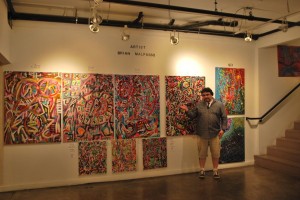
Local Las Vegas artist, Brian Malpasso showing his paintings.
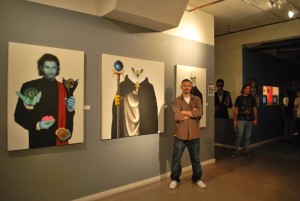
Carlos De Las Heras showing paintings from his series “The Planet Earth Awards, Beyond Superstition”.
Now that the July events are behind me, it’s time to update mailing lists, post pictures and write blogs. Then, it’s on to more creating, thinking about titles, planning…
Photos credit – Trillian
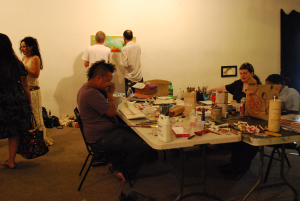
Paint-ins seem to be becoming “the thing” in the Las Vegas arts community. We had an outdoor group painting session in late spring. Now, there’s a regular “Third Friday” paint-in at Place Gallery, organized and hosted by Gina Quaranto. There is a nice, large area that works well for many artists to gather and work. Many mediums and styles were represented. There was painting in different media, sculpting, and a number of artists were working on their skate decks for LVSK8IV The Skate Deck Art Show
Creativity fills the air. You can breathe it in and use it. Artists are lost in what they are creating. And, then, they may be wandering around checking out what other artists are doing. I think the camaraderie is good for all. An arts community is what keeps a lot, if not all, of us going. We get support and encouragement, which is always needed. We build friendships. We try to give back in the ways that we can.
It takes some effort to haul all the needed supplies for painting somewhere other than your own studio. But, it can be worth it. Group painting offers some things we don’t get alone, holed up in our studios, which is our natural habitat. Aside from the camaraderie, you also get some publicity of sorts. It may just be word-of-mouth, someone who stopped in to watch mentioning they’d watched you paint. Or, it may be a possible collector who has seen your work on exhibit, who now gets to see you working. You’d be surprised how many people are fascinated by seeing an artist at work. Keep in mind that this is totally foreign to most people who are not artists. It may seem humdrum and everyday to you because that IS your life. You do it almost by rote. But, to the layman it may be magic. And, don’t forget, collectors and all buyers are buying a piece of the artist. Meeting you, seeing you in action, talking to you about your work or your methods, all provide fodder for the collector’s interesting story for his friends. Also, connecting with the other artists can be worthwhile beyond just the friendship and camaraderie. The artists here in Vegas are generous with their support of each other. Your name might come up when there’s an exhibition opportunity. And, last, but not least – it’s good to get out of your studio and participate in life! You need ideas for your work, life experiences! You need to fill the well!
Here is my painting after the session at Third Friday Paint-In. I will work on it more in my studio and post a picture when it’s completed.

Have you painted with a group? Do you enjoy it? What benefits or pitfalls do you find in painting with others present?
"History in the Making"
Tension in a painting can be interesting, as well as useful. I like tension in a painting. It can be used by the artist to direct the viewer’s eye where he/she wants it to go. An example of what the artist does NOT want to do is direct the viewer’s eye OUT of the painting. For instance, a profile portrait placed too close to the edge where the sitter is looking “out” – actually directs the viewer’s eye out of the painting. Never to return. Viewer moves on to next artwork. You’ve lost your viewer!
In my painting, “Every Day Is History in the Making” it’s pretty easy to see the tension. I was aware of it while I was working on the piece. I decided I liked it, so I kept it and used it to my advantage. It’s easy to spot the darkest dark and the lightest light. That is my center of interest, which I established right away in the painting. At some point, while studying my progress, I decided that the lightest light was TOO harsh. It needed softening. I felt that additional paint and/or brush strokes was not the answer. I didn’t want to muck it up, so to speak. So, I chose to use silver spray paint. It softened the hard edges that were bothering me. It kept it light (silver is very reflective).
The next thing I noticed while studying my progress was that there was a large dark area to the right that was competing with my darkest dark. It had some other marks in it to break it up a bit. And, it was slightly gradated from solid dark to a little less dark. But, that was splitting hairs. The fact is that it was really competing. My eye kept being pulled from the center of interest (lightest light/darkest dark) to the very dark shape at the right…and, then, back again. I decided I really liked that. I liked the tension. I also liked that it kept the viewer’s eye in the picture. I wasn’t leading the eye out of the picture and away from my art. Mission accomplished!
"Don't Suck Me In"
Another good example of tension can be seen in my recently completed work, “Don’t Suck Me In”. I started that piece with a challenge to myself. I placed my lightest light and darkest dark as my center of interest. Both are quite small. The challenge was to see if it would hold up as the center of interest even though it was small. I did also use red right next to it sort of as an insurance policy. Red will always catch the eye.
If you followed my previous posts about the evolution of “Don’t Suck Me In”, you know that the big sequins were the last addition to the work. And, they really create some tension. It’s pretty hard not to catch the eye with big, silvery, glimmering sequins blowing in the wind! Yet, my intended center of interest is over to the right where the little bitty white and black areas (and some red) are. Again, I find that my eye goes back and forth from the intended center of interest to the sequins. This is great! The whole meaning of the work is tied up in tension. If you noticed the snakeskin under the paint near the center of interest…tension! Then, the title suggests getting sucked in. Sucked in to what? Well, that’s up to you. But, the words that are written along the right sight suggest some possibilities. As long as the eye is kept inside the picture plane, I feel it has been successful. The more time the viewer is kept inside the painting, the more time he has to find the more nuanced areas that may suggest more nuanced meaning.
So, now you know some things I think about while working. I hope you found it interesting. Feel free to give me some feedback. I know how the artist thinks. I’m very curious about what the viewer sees and thinks. What catches and holds YOUR attention?

“Don’t Suck Me In”
25″x31″x2″
Now, for the fun! As I said in the last post, I already had the idea for the coup de grace. I just needed for the white paint to dry before installing it. I wanted sequins – big, shiny, tacky sequins. You’ve seen them before, usually on used car lots or sleazy liquor stores. Big, shiny sequins blowing in the wind, catching the sunlight and glinting with each flutter. I hunted for big sequins. I couldn’t find any ready-made. So, what’s an artist to do? Make them, of course! I cut out circles of metal and punched holes with my paper punch. I wasn’t sure if the paper punch would be strong enough to do the trick, but I got lucky. Then, I had to install them. I used double point tacks.
I don’t know if you can see the words I have lettered in towards the right side of the painting like you would if it were full resolution:
- opportunity
- prosperity
- Growth
- possibilities
- expansion
The painting has meaning to me. Maybe it does for you, too.
“Can We Get There From Here?”
36″x48″x3″
Oil/Mixed Media on Panel
Yup, JILL. That would be the feminine for…you got it – jack of all trades. I suppose I shouldn’t focus on gender. All of us artists are up against the same thing: the need to be able to do it all. It seems that ALL is getting bigger and broader and more demanding.
I wish that being an artist meant that one would CREATE ART. That’s all. Times have changed. Our needs have changed. And, there’s more than ever to do as an artist. There’s so much preparation. There’s promoting oneself. Showing the work. Being a good salesperson. Keeping accurate records.
Before I can begin a painting I have to come up with a painting surface. Sure, surfaces are available to buy. But, there are many things to consider. What kind of surface do you want? Can you afford to buy a prepared surface of the quality you want? Or, if you want a “custom” surface that isn’t manufactured, you will need to create it yourself. This is where the “fun” begins. A knowledge of building materials and tools comes in handy. Tools needed to build the surface are needed. And, a place to work at building is needed. Time is spent building the painting surfaces.
The best part, for me, is the actual creating of the artwork. I get the most joy out of painting and whatever else is involved in the creation of my work. I work rather quickly as far as the actual painting goes. But, I can spend a lot of time thinking, viewing, coming up with ideas of “what’s next”. Do I want to include this or that, do I want to add this or that found object, do I want to add marks in pencil, oil stick or spray paint? This is where I really enjoy the process. These are the decisions that truly affect the final outcome of the work. The answers to each of these questions make or break the success of of the work. I love it when I feel like I’ve made the right decisions.
Now, I need to be able to promote myself. In the past that meant being able to photograph your work well (or hire a professional photographer), keeping your resume up-to-date and searching for opportunities to show your work. Opportunities to show your work is still the goal today. But, there are so many more opportunities for promoting yourself. Hello, computer! If one has the skills to create one’s own website and keep it up-to-date and photograph and photoshop one’s work – that One is in good shape! Hooray for you! If, on the other hand, one (ME) is a bit of a dinosaur in this area – there is a lot of frustration. I feel like I’m spending all my time learning how to do everything that needs doing. And, where is my painting time?
Well, I’m not giving up! I’m still plugging away at it all. This painting, “Can We Get There From Here?” shows how making one’s own painting surface contributes to the end result of the painting. I’ve altered the shape of the rectangular surface by cutting out three semi-circles with my handy-dandy electric jigsaw. I photographed the finished work. With help from my fabulous webmaster, Trillian, I’ve come up with an image of the work. She’s still working with me on how to do all this stuff.
I’m always looking for opportunities to show and sell my work. I watch for competitions that I feel are worthwhile to enter. And, when things go well, I have to get down to good record keeping!

“Downsize”
Found objects. What are they? I guess you could say that they are anything that you find! They can be interesting to add to your artwork. It’s not a new concept. Many artists have included found objects in their work. I use them sometimes. Not every painting calls for their use. I don’t want to overdo the practice. I don’t want to be known as the woman who ALWAYS includes found objects in her work! If they add something to the work I like them.
Finding found objects can be fun…or frustrating. I always have my eyes open looking for them. You have to know a good found object when you see it. It can be anything and it can be anywhere. I happen to appreciate old, very used and textural objects. I also appreciate “weird” objects, things one wouldn’t even think of using. Those are the best! One needs to be continuously collecting these found objects. They may not get used for quite some time…or maybe never. But, a good collection is needed. All you neat, tidy, organized people will be cringing about now. But, a good trash pile is like manna! When a work “needs something” you go to your collection of found objects and pick through it, looking for just the right thing.
Sometimes these found objects serve more than one purpose. I have a couple of great finds that have ended up being used for printing textures onto painting surfaces rather than being added to the work. I also have a great piece that I use for a “stencil” of sorts. It has lots of round holes that I use to spray paint through. I also have found objects that I use both for texture on a painting surface and as a stencil. You just need to keep your eyes and your mind open. One of my favorite finds is the plastic netting used on the outside of a Butterball turkey. It’s the perfect example of a find that I’ve used on my surface as texture…AND as a stencil to spray paint through.
It’s time to go on a treasure hunt. I happen to have two paintings in progress that I feel need found objects to complete them. And, sadly, I don’t seem to have the right thing in my treasure pile. It seems like I’m trying too hard to find the perfect found object. The better way is to have found great stuff and have it waiting for the perfect opportunity.
The painting I’m showing, “Downsize” is an example of using found objects. The painting surface itself is a found object: a small pallet. And, there are several found objects added to it at the end.
“Zoning Permit Required”
I love titles! Titles may give me a clue as to what a painting is about, or, at least, the artist’s thoughts on the work. I hate to see untitled w
orks. When I see a painting that really intrigues me and I look for the title I am SO disappointed when I see “untitled’. I feel like the artist hasn’t finished his/her job when it’s left untitled. True, each viewer finds his/her own vision. But, it’s nice to get a clue about the artist’s vision as well. Don’t you wonder WHY an artist created a work of art – or what he/she was thinking while making it?
I work in the abstract so “what it’s about” is really up for grabs! I feel like most of my work is about whatever the viewer thinks it’s about. And, what I think it’s about can often be more than one thing. I actu
ally enjoy coming up with titles. Sometimes they come easy. And, sometimes I really labor over them. I may study the finished work for days on end before I come up with something that I like, that seems to fit, that could work. Usually, when I finally come up with it, it seems to be perfect…for me, anyway. I enjoy titles that make the viewer wonder. It seems to me that if the viewer wonders what the title means, he/she must be thinking about it. That’s great! I like to think I made someone think!
So – what do YOU think? Do you like titles? Or, are they not that important to you?



